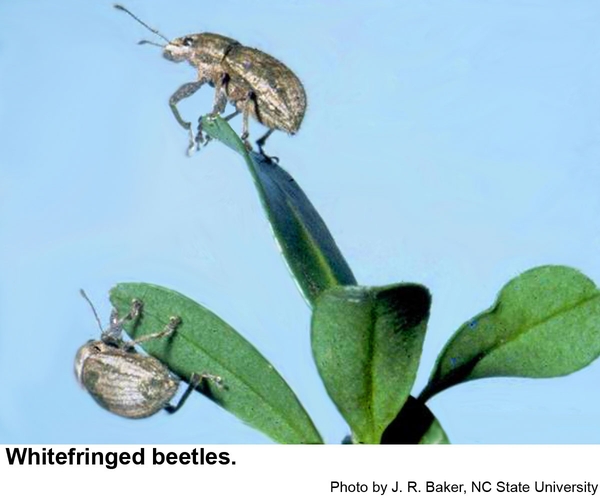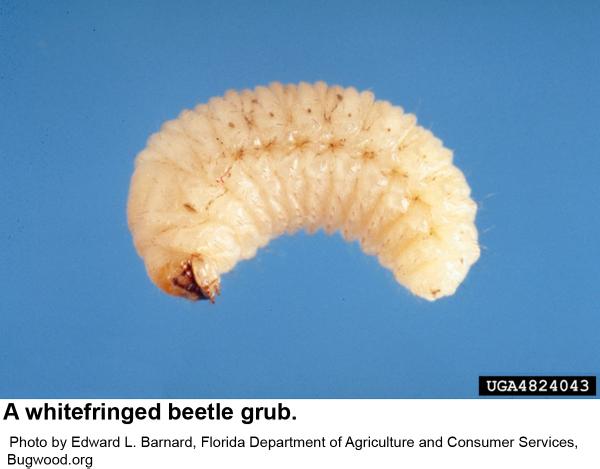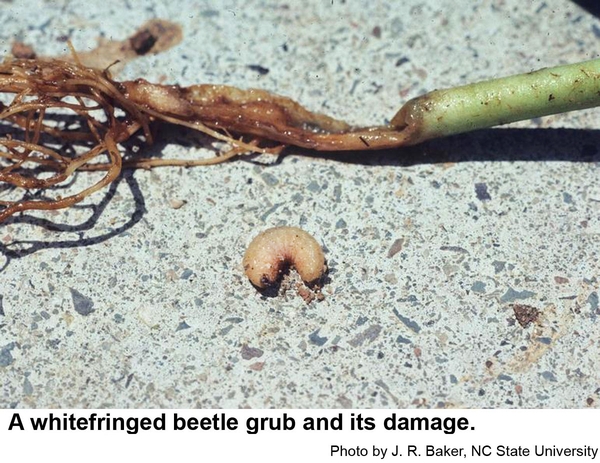Description and Biology
The whitefringed beetle, Naupactus leucoloma, is a conundrum because there is so much variation in the population. There seem to be a number of species involved in the "whitefringed beetle complex," but as there are no male whitefringed beetles in North America, crosses are impossible to make so they are all lumped together as "whitefringed beetles." Naupactus minor, Naupactus peregrinus, and Naupactus fecundus are also called whitefringed beetles although if cross-breeding were possible, they might all prove to be the same species. Adults are light to dark gray or brown, usually with a light band along the outer margins (the white fringe), and two pale lines or blotches along each side of the thorax and head. They are about 1/2 inch long. Whitefringed beetles are flightless but may may crawl up to 3/4 of a mile. Eggs are deposited in masses held together by a sticky substance that hardens upon drying. They are usually laid on or just below the surface of the soil. Whitefringed beetle larvae are C-shaped, pale, fat, legless grubs that grow up to 1/2 inch long. Grubs overwinter and continue feeding before pupating in the soil the following spring. Emergence begins in May and continues throughout the summer. Adults live for two or three months. Each female can lay 600 to 700 eggs. There is one generation per year although some grubs may not pupate until their second spring.
Host Plants
Whitefringed beetles have been found feeding on 385 species of trees, shrubs and ornamental plants as well as vegetable and field crops. Adults often feed gregariously, and as many as 200 or 300 beetles may be found on one plant. Adults feed on the edges of leaves rather than chewing holes. However, the most serious damage to plant health is caused by the grubs feeding on roots.
Residential Recommendations
Because whitefringed beetles are parthenogentic, selection for resistance is not likely to happen. Most of the insecticides labeled for landscape use should give adequate control. Consider using one of the pyrethroids as they tend to have longer residual activity. When used as directed, pyrethroids are very toxic to insects but are not particularly hazardous to humans and pets (other than fish—avoid using pyrethroids around pools, ponds, and streams).
Other Resources
- Common name: whitefringed beetles, scientific name: Naupactus (=Graphognathus) spp. (Insecta: Coleoptera: Curculionidae). Dixon, W. N. 2008 (revised). Featured Creatures, Entomology & Nematology, FDACS/DPI, EDIS, University of Florida. Publication Number: EENY-294
- Whitefringed Beetle, Scientific name: Naupactus leucoloma (Boheman); Naupactus minor (Buchanan); Naupactus peregrinus (Buchanan). O'Sullivan, J. No Date. Sweetpotato DiagNotes: A Diagnostic Key and Information Tool for Sweetpotato Problems,
- Whitefringed beetles (Naupactus spp.) (Coleoptera: Curculionidae). Anonymous. No Date. Forest Pest Insects in North America: a Photographic Guide
- Insect and related pests of vegetables. Sorensen, K. A. and J. R. Baker eds. 1994. North Carolina Agricultural Extension Service publication AG-295. 180 pp.
- Extension Plant Pathology Publications and Factsheets
- Horticultural Science Publications
- North Carolina Agricultural Chemicals Manual
For assistance with a specific problem, contact your local N.C. Cooperative Extension center.
This Factsheet has not been peer reviewed.
Publication date: March 21, 2019
Reviewed/Revised: Jan. 10, 2024
Recommendations for the use of agricultural chemicals are included in this publication as a convenience to the reader. The use of brand names and any mention or listing of commercial products or services in this publication does not imply endorsement by NC State University or N.C. A&T State University nor discrimination against similar products or services not mentioned. Individuals who use agricultural chemicals are responsible for ensuring that the intended use complies with current regulations and conforms to the product label. Be sure to obtain current information about usage regulations and examine a current product label before applying any chemical. For assistance, contact your local N.C. Cooperative Extension county center.
N.C. Cooperative Extension prohibits discrimination and harassment regardless of age, color, disability, family and marital status, gender identity, national origin, political beliefs, race, religion, sex (including pregnancy), sexual orientation and veteran status.



